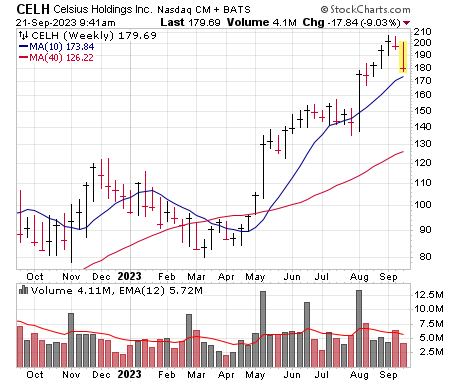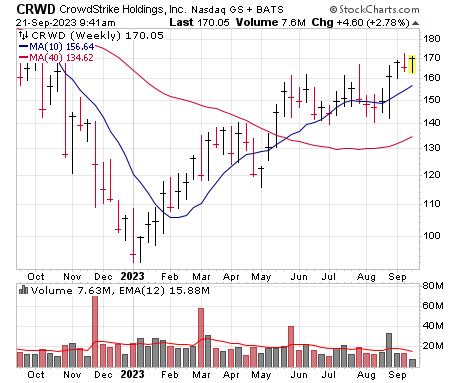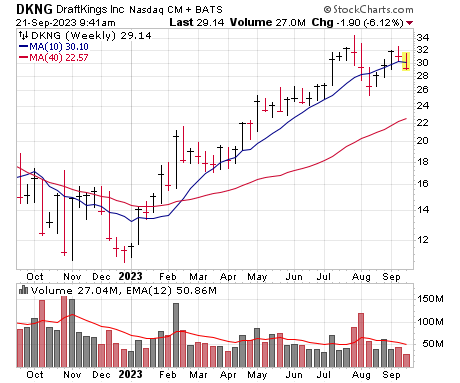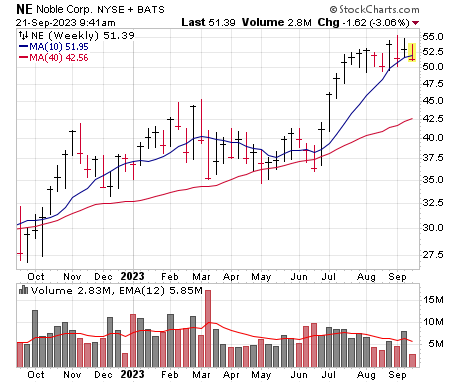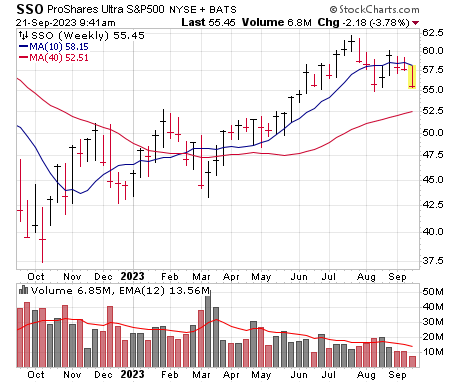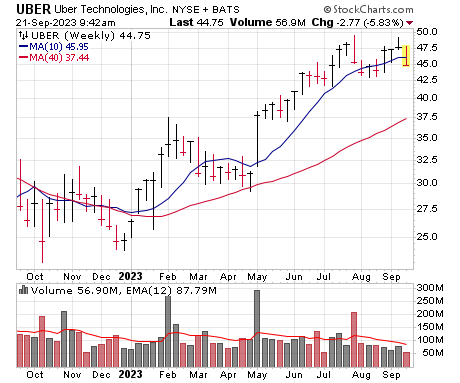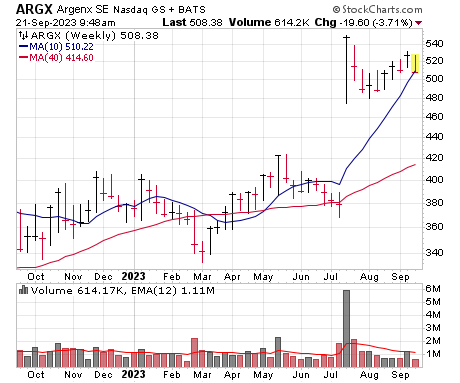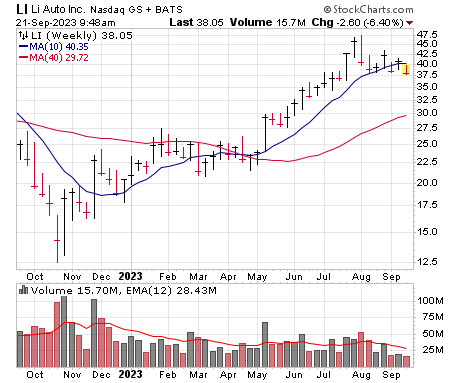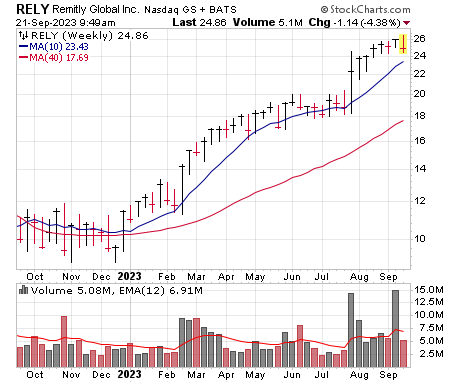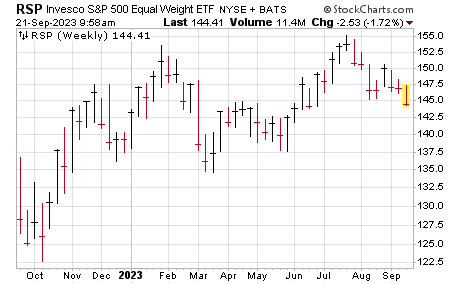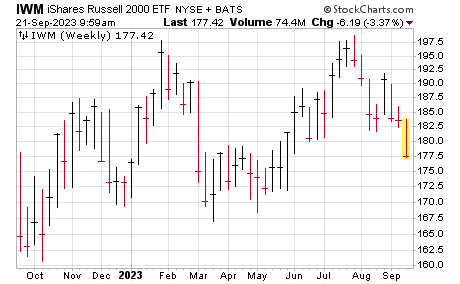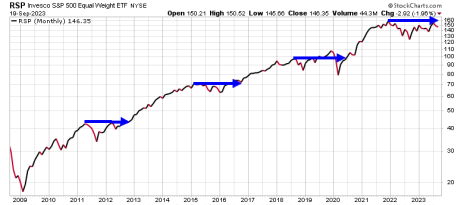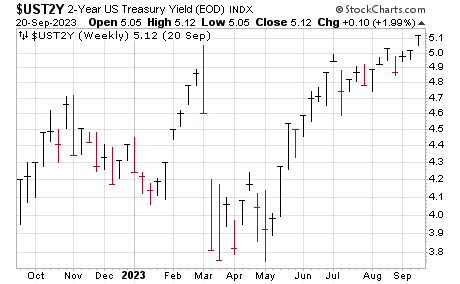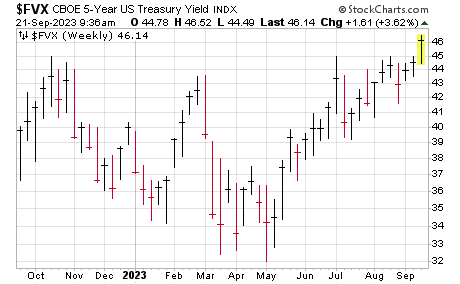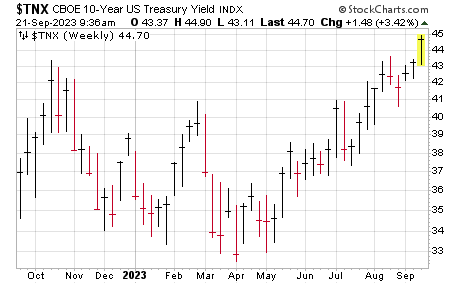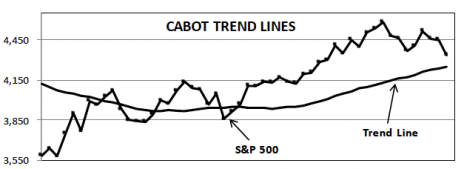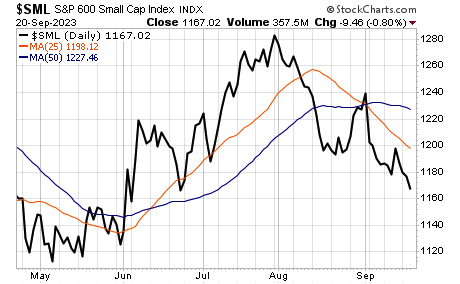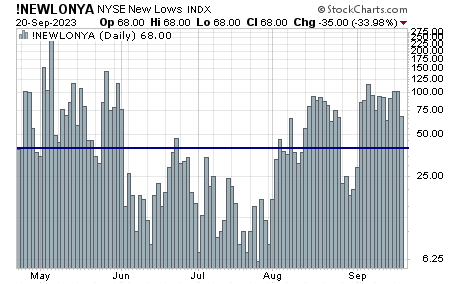Rising Rates Too Much to Handle
During the past year and a half, the market has had a few solid rallies, with each looking promising and partially built on the belief that the Fed was nearly done with its tightening efforts and that the world could instead focus on earnings, growth and the next big themes that will improve our lives. But each time, the interest rate story has come back from the dead to scare away big investors and bring on the sellers.
Last summer was the first go-round of this, and the very promising and broad October-January rally was another. (In fact, that January high was effectively the top for the broad market this year—see more on that later in this issue.) And now we’re dealing with another assault from the bond market, with interest rates breaking out on the upside (again, see more on this later in the issue), causing the major indexes to sag and the broad market (nearly 80% of stocks below their 50-day lines!) to keel over.
Now, to be fair, it’s not a complete horror show out there: The big-cap indexes are still within their two-month ranges for now, the longer-term trend is still up and, while there aren’t tons of stocks ready to get going tomorrow, we’re still seeing a lot of “normal” base-building efforts out there. (While it’s taken on water with everything else this month, our Aggression Index is still well above its August lows, unlike most indexes—another small positive.) Throw in the fact that sentiment is deeply negative again and we still see the odds favoring the next major, sustained move being up.
Even so, we always go with what we see, and there’s no question that the reasonable correction and encouraging snap back in late August has run into a selling buzz saw, with selling pressures picking up this week and with next to nothing in the midst of a strong intermediate-term uptrend.
And, really, that last point is our main thought: The fact is that there’s no real money being made in this environment, especially if you’re an intermediate- to longer-term investor like us. That doesn’t mean things can’t change—eventually, they will, and the fact that we’re already a couple of years into this process means the turn should be sooner rather than later.
What to Do Now
But right now, it’s best to remain in a cautious stance and protect yourself while the sellers are in control. We came into this week with a cash position in the mid-40% range, and tonight we’re raising some more, selling one-third of our current positions in both Celsius (CELH) and the ProShares S&P 500 Fund (SSO); we’re also placing Noble (NE) and Uber (UBER) on Hold. That will boost our cash position into the low-50% area, giving us more cushion as we fine-tune our watch list so we’re ready for the sustained rally that’s over the horizon.
Model Portfolio Update
The market as a whole and growth stocks are under the gun, with the slippage that began a couple of weeks ago picking up steam after yesterday’s Fed meeting. Most of the intermediate-term evidence remains on the bearish (or at least not bullish) side of the fence, and when you throw in the fact that interest rates are leaping above key levels and late September is nearly always a challenging time, it’s best to remain in a cautious stance.
Our optimism that there’s another big upleg on the horizon hasn’t changed given the still-positive longer-term trend and the “normal” (albeit tedious) correction to this point. Still, with much of the market still effectively trying to transition from bear to bull (again, see more on that later in this issue), and with growth stocks very on-again, off-again, we believe a healthy dose of patience is the correct prescription.
Given the recent weakness, we’re paring back further today, selling some more of Celsius (CELH) and a chunk of our ProShares S&P 500 Fund (SSO)—those moves should bring our cash position up to a bit over 50%. We’re not anxious to go into a full defensive stance given the longer-term positives and, really, the decent number of solid-looking charts out there in the growth world; indeed, if the bulls can make a stick save here, we don’t think it would be long before we’d be adding some new names.
But right now, there’s no question the tide is going out for most everything, so we advise staying relatively close to shore.
CURRENT RECOMMENDATIONS
| Stock | No. of Shares | Portfolio Weightings | Price Bought | Date Bought | Price on 9/21/23 | Profit | Rating |
| Celsius (CELH) | 571 | 5% | 142 | 6/2/23 | 170 | 20% | Sell a Third, Hold the Rest |
| CrowdStrike (CRWD) | 565 | 5% | 163 | 9/1/23 | 163 | 0% | Buy a Half |
| DraftKings (DKNG) | 3,646 | 6% | 25 | 6/23/23 | 29 | 15% | Hold Half |
| Noble (NE) | 3,501 | 10% | 52 | 8/25/23 | 51 | -3% | Hold |
| ProShares Ultra S&P 500 Fund (SSO) | 3,199 | 10% | 53 | 1/13/23 | 55 | 3% | Sell a Third, Hold the Rest |
| Uber (UBER) | 4,542 | 11% | 40 | 5/19/23 | 45 | 12% | Hold |
| CASH | $929,036 | 52% |
Celsius (CELH)—We had been thinking a correction was likely in CELH given the stock’s run, some resistance that popped up near 200 and the iffy market, but instead of a normal retreat shares have plunged—the stock was whacked yesterday and again today on big volume, with shares all the way to and a bit below their 50-day line. If this were a positive market environment, we might sit tight, expecting some further short-term wobbles but also thinking the dip would provide a decent entry to start a position. That’s certainly a possibility, as nothing going on in the world (interest rates, economic fears, etc.) should undo the company’s tremendous growth story now that the Pepsi partnership is firing on all cylinders—heck, one analyst actually said this morning that retail data showed accelerating growth of Celsius’ products (year-on-year sales of 160%) and hiked his EBITDA estimates. But the fact is the market is not healthy, which is outweighing everything else when it comes to the stock. The big picture here is fine, but on our special bulletin this afternoon we sold one-third of our remaining stake—we’ll give the rest a little wiggle room, seeing how it fares after the selling wave. SOLD ONE THIRD, HOLD THE REST
CrowdStrike (CRWD)—CRWD has thrashed back and forth of late, but overall we think it’s the action is acceptable given the environment. The firm has unleashed a fire hose of press releases this month, highlighted by a handful of next-generation upgrades/advances of its Falcon platform and AI capabilities, a new partner program that should help boost sales, a marketplace for third-party products that work with its platform and a no-code development platform that allows clients to build upon Falcon. But the big news came last night: While management didn’t officially raise near-term guidance, it did significantly boost its “target model” of margins to be achieved during the next three to five years, including a boost of nine percentage points (!) to its operating margin target and a boost of five percentage points (to 36%-ish) to its free cash flow margins—all while the top brass threw out talk of $10 billion of annualized recurring revenue within five to seven years (compared to nearly $3 billion today). Again, that wasn’t “official” guidance, but it didn’t stop a bevy of upgrades and reiterations from Wall Street this morning. Near-term, this doesn’t mean CRWD is going to ignore the market’s weakness, but it should entice some buying on dips—as should the buyout of Splunk (SPLK) today by Cisco (CSCO), as SPLK has a bit of a cybersecurity angle. We’re hanging onto our half-sized stake, and if you don’t own some, are OK starting a position here or on weakness. BUY A HALF
DraftKings (DKNG)—DKNG rallied all the way back toward new closing highs two weeks ago (very encouraging, especially after the prior nose-dive related to ESPN), but like most things, the buying power ran dry near resistance, with shares getting hit since then. Even so, the stock is firmly in the middle of its range of the past couple of months, which is more resilient than most major indexes and potential leading stocks. There have been no official updates on how the sports betting industry is faring early in the football season (generally the busiest time of the year for the sector), though there’s optimism given some studies and estimates that the industry is still seeing big growth even among long-time users. If the stock can generally hold here and eventually accelerate higher during a more supportive market, we’ll fill out our position—we still think DKNG quacks like an emerging blue chip and should see accelerated profitability going ahead. If you wanted to nibble here we wouldn’t argue with you, but officially we’ll stay on Hold and wait to see if the stock and market can give an all-clear going forward. HOLD HALF
Noble (NE)—Oil prices themselves have been kiting higher of late, conquering the $90 level, but oil stocks of all sorts of have hesitated, with some like Noble pulling in to support (near the 50-day line). Of course, there’s little doubt that business remains good and will get better—while the company has been quiet on the news front, peers Valaris (VAL) and (especially) Transocean (RIG) have announced some fresh deals for their rigs of late, confirming that the market remains robust, as you’d expect. Even so, given the market and the fact that oil/oil stocks have diverged, we’re going to be cautious and move our rating to Hold—hopefully that’s the wrong call and NE resumes its advance in short order, but in this environment, we’d rather take a step toward the shore and watch how things unfold. HOLD
ProShares Ultra S&P 500 Fund (SSO)—From a big-picture perspective, not much has changed when looking at the market—the odds still favor the next major market move being up, and that’s why we’ve held SSO through the initial July/August dip and ensuing bounce. But the recent weakness, while not a longer-term death knell, is more worrisome—the comparisons from 2003 and 2009 have mostly fallen by the wayside, and the fact is more and more intermediate-term evidence is turning down. If we had a small position here we probably wouldn’t be doing anything, but given that we own a good-sized stake, we decided to sell one-third of our position on a special bulletin earlier today. Obviously, if the market remains weak, we could trim further, but with the S&P 500 and SSO near their August lows, we’re OK giving our remaining stake a bit of wiggle room to see what happens as the dust settles from the post-Fed selloff. SOLD ONE THIRD, HOLD THE REST
Uber (UBER)—It looks like one of Uber’s recurring bugaboos—regulation trying to make drivers full-time employees—could be an issue in Europe, though Uber said it wouldn’t affect its profitability (instead using third parties to drive), though it would likely slash availability and boost wait times. Still, that wasn’t a focus of big investors before this recent selloff, so we think the recent retreat is all about the market itself. Longer-term we’re optimistic the focus on the growth seen in the underlying business and excitement surrounding some of the tidbits management revealed at its talk a couple of weeks ago will keep the major trend up. Of course, right now the fundamentals are taking a back seat to the market, which is pressuring just about every name out there. We’ll switch our rating to Hold and see how UBER acts going ahead; so far, it’s fine, but we think it’s prudent to see what transpires after this knee-jerk selling. HOLD
Watch List
- Argenx (ARGX 505): Biotechs have been out of favor forever, but if they turn up in the next advance, ARGX has the makings of a name institutions will gravitate toward, with a mega-blockbuster drug that’s just gaining traction in one indication, with many more to come. See more below.
- Axcelis (ACLS 155): To be frank, ACLS is looking a bit toppy at this point, with the 190 to 200 area being a ceiling since July and with zero above-average volume buying weeks since May. Still, the fundamentals here are pristine (might be the go-to way to play the SiC chip boom), and some hacking around was well deserved after the first-half run.
- Duolingo (DUOL 152): DUOL has finally come in, which isn’t a surprise, but overall the stock is still well within its launching pad from the past few months. We like the non-tech growth story here with booming free cash flow and a clear leadership position in its area.
- Mobileye (MBLY 41): MBLY has always had a great story, but 2023 is a transition year as its autonomous driving products (and ADAS offerings) gain traction. Now the stock is starting to round out a base—there’s still lots of overhead to chew through, but it’s a good start in a tough market.
- Remitly (RELY 25)—Remitly has a unique story, effectively bringing the huge remittance industry into the digital age, with big advantages for users. It’s a bit thinly traded but is growing up fast. See more below.
Vertiv (VRT 36): VRT might be the top name on our watch list right now—after a huge run, you’d expect some serious weakness given what we’re seeing in the market (and even in AI stocks), but instead the pullback has been very reasonable.
Other Stocks of Interest
Argenx (ARGX 505): Biotech stocks have been the dog’s dinner this year, with the group 21% off its yearly high and closing in on new lows—and this comes after years of lethargic action too. Even so, eventually, the medical/biotech field is going to come to life, and there are a couple of names we’re eyeing right now. One of them is Argenx, which has a big market cap ($29 billion) and valuation (25x revenue estimates from this year), but when you dig into the story it’s easy to see why. Right now, the firm’s story revolves around Vyvgart, which was approved in the U.S. in late 2021 (and most everywhere else in the 18 months that followed) for the treatment of generalized myasthenia gravis (dubbed gMG, which causes weakness in skeletal muscles), which itself is a big indication; Argenx’s sales have basically gone from nothing in mid-2021 to $281 million in Q3 of this year, with further growth ahead. But gMG is just the beginning—a recent Phase II trial showed Vyvgart was very successful (greater than 60% clinical evidence of success) in treating a neurological disease that reduces senses in the arms and legs. And beyond that, there are nearly a dozen autoimmune indications for Vyvgart in various stages of trials, each of which could take aim at patient populations in the tens of thousands, not to mention some other drugs it’s evaluating that are in early-stage trials. To be fair, for the stock, that will result in a steady stream of data readouts (read: event risk), but big picture, some analysts see peak sales for Vyvgart north of $10 billion annually (!), with the latest positive Phase II trials lending credence to the fact that the drug has a ton of applications. As it stands now, Argenx is expected to bring in $1.15 billion in revenue this year and $1.6 billion next, but both of those are likely conservative as the drug continues to gain traction around the world (and a new subcutaneous version of the treatment is approved, thanks to partner Halozyme). The stock was essentially capped by the 400 area from late 2022 but then finally gapped through that on record volume after the recent trial data—and since then ARGX has consolidated in a reasonable range as the market has been correcting. Once again, the valuation is hard to stomach in an iffy environment, but the big long-term breakout and one-of-a-kind product in Vyvgart should keep big investors interested.
Li Auto (LI 38): Tesla still gets most of the hype for electric vehicles, and for good reason, but Li Auto is a big Chinese player that should have a bright future. The firm obviously specializes in EVs, but so far it’s been in what they call extended range electric vehicles (EREVs)—think of it as a beefed up plug-in hybrid, with a gas engine along with a big battery that combined can provide 800 miles of range (including 100 to 200 miles of just electric range if wanted). Moreover, the cars are on the fancier side, with many of the latest smart offerings and with advanced driver assist features, and the company focuses on SUVs—it has three models now (L7, L8 and L9) and all are selling fast. Li has sold more than 400,000 vehicles since starting production in late 2019, and in Q2, it delivered 86,533 cars, triple that of a year ago, with another 100,000-plus expected in Q3. (The firm releases delivery numbers at the start of each month; in August, the figure was nearly 35,000, with each of the three models registering north of 10,000 unit sales.) Of course, the future will be more about pure battery offerings, and Li on top of that, too—it’s debuted the Li Mega, a luxury offering that will sell for $70,000 or so in China and hit the market in December, with management saying it will be the biggest selling automobile in China ever at that price; in preparation, the firm is building out a charging network, with 100 locations by the end of this month, 300 by year-end and 3,000 by 2025 (mostly along highways). Revenues nearly tripled in Q2, and while that growth will slow, analysts see earnings up about 75% next year to $1.39 per share. LI broke out in May and had a solid run that took shares a few strides into new-high ground before pulling back the past seven weeks as it consolidates its gains. Yes, Chinese stocks certainly have political risks, but LI’s sponsorship is decent (363 funds own shares, though that’s been falling in recent quarters) and the story is straightforward. Another little bit of consolidation would be normal, but a powerful upside move from this area may signal a resumption of the overall advance.
Remitly (RELY 25): So here’s a new story that could have legs: Remitly is upending the remittance industry, where people living and working abroad send money back to family members. Worldwide, there’s $626 billion of remittances sent each year, but the average cost to do so (via fees and what-not) is 8%. Remitly has taken the sector into the digital age, allowing recipients to avoid standing in line and talking with an agent and instead sending money right from an app for far lower fees (less than 2% according to the company), and thanks to its distribution network it has wide reach, including four billion eligible bank accounts, 1.1 billion mobile wallet and other alternative accounts and even a few hundred thousand cash pickup locations in more than 170 countries. (The network has been put together by a ton of partnerships, so Remitly doesn’t have to have operations set up in a ton of countries, which keeps costs in check.) It’s a simple story where a leader can take huge share in an old, stodgy sector, and the firm is off to a great start: In Q2, revenues lifted 49%, while active users totaled five million (up 47%) and gross send volume came in at $9.6 billion (up 38%); the bottom line was in the red, though EBITDA was in the black at $20 million. The U.S. is the big draw as you’d expect (two-thirds of revenue, up 36% from a year ago), but things are picking up elsewhere, with Canada (12% of revenue, growing 44%) and especially the rest of the world (20% of revenue, up 120%!) expanding at even faster clips. As with most growth firms, analysts see growth slowing into next year, but we’re guessing that will prove conservative as business trends here are strong and a lot of sales come in from word-of-mouth. Now, to be fair, given Remitly’s business, politics could play a role in investor perception, which is something to be aware of given next year’s elections, but there’s no question the underlying business is humming today. RELY is a bit thinly traded but is growing up, with shares changing character after a long bear-and-bottoming phase in 2021/2022, gapping up strongly after earnings in early August. We’re not in a chasing mood here, but it’s a unique story that more big investors are discovering (fund ownership of 191, 236, 206, 337 the past four quarters). It’s on our watch list.
Much of the Market Is Still Switching from Bear to Bull
(But It’s All Part of the Process)
The market has a normal pattern when it goes from bear to bull, usually (a) taking some time to bottom out; could be weeks if it’s a short bear phase but months if it’s a longer one, and (b) when it takes off, nearly all of the market will get going initially, as whatever pressure that was keeping the market under wraps dissipates.
This year started out that way—the 2-to-1 Blastoff Indicator flashed in January of this year as there was a rush of buying across the entire market. It’s not unusual for many things to pull back after such a buying spree, but the unique thing this year is that late January/early February actually marked the top (or very close to it) for wide swaths of the market.
While some mega-cap names and a few themes like AI did well for a spell, the fact is that most of the market still looks to be in a long process of transitioning from a bear market to a real, true bull phase. Shown here are weekly charts of the equal-weight S&P 500 Fund (RSP) and the small-cap Russell 2000 Fund (IWM) — RSP looks a bit better overall, but neither really conquered their January peak and both are stuck in ranges they’ve occupied going back to late last year.
For the time being, knowing that most of the market is still stuck in the muck means you should treat this differently than, say, a normal modest intermediate-term pullback in a strong market uptrend—that’s why we’re holding more cash, keeping new buys on the small side and the like.
Of course, all of that is descriptive, not predictive—as we’ve written numerous times, the combination of a still-bullish Cabot Trend Lines and tons of studies of the market action of recent months point to higher prices down the road. And it turns out taking a gander at recent history shows that what the market’s been going through isn’t unusual at all.
Above is the monthly chart of that same equal-weight S&P 500 Fund, going back to the major low of 2009; you can see that even in the strong market period of that time, we’ve seen plenty of occasions where the average big-cap stock takes a year or two off: The first came in 2011-2012, with around a year and a half of no progress before the 2013 blastoff took hold; the wear-you-out bear market of 2015-2016 was about the same length, ending after the 2016 Presidential election; and, while not as clean, RSP did nothing net-net from late 2018 until mid-2020 as the trade war and pandemic held the market back. (It’s been a very similar picture during the past decade with growth-oriented funds, too.)
At this point, we’re working on 20 months of the current “consolidation”—it’s been a slog, of course, but if the Fed can call off the dogs, rates come down (see below) and the market responds, it’s likely the market can finally kick off the sustained rally we’ve all been waiting for.
Interest Rates Break Out on Upside
The headline here pretty much says it all. While the bond market (interest rates) are a secondary indicator for the market, you don’t have to run a hedge fund to realize that rates have been one of, if not the, key driver of the market during the past couple of years. And today, just about all rates across the board broke out above key levels.
Shown here are charts we’ve shown a few times in recent issues: The yield on the two-year, five-year and 10-year Treasury notes. All of them were running higher earlier this year, which stopped the promising October 2022-January 2023 rally in its tracks (see above)—but then rates dipped in a big way when the March banking issues surfaced and stayed down for a while. And even the rally in interest rates that occurred after that wasn’t overly worrisome, with rates still below their prior highs.
But that hasn’t lasted—the uptrend in rates remains persistent, with bonds dipping and rates making new highs. Obviously, if the market and growth stocks turn tail and rally strongly, we’ll pay attention to that first and foremost, but given recent history, it’s possible we may need to see at least some backing off in rates for big investors to step up in a real way.
Cabot Market Timing Indicators
There remain more than a few big-picture positives out there, but we always go with what we see in front of us—and right now, our Tides and Two-Second Indicator are negative, the selling pressures are accelerating and interest rates remain a thorn in the market’s side. We remain cautious and patient as we wait for the sellers to exhaust themselves.
Cabot Trend Lines: Bullish
There’s less wiggle room than before, but our Cabot Trend Lines remain in a positive stance, with the S&P 500 (by more than 2%) and Nasdaq (by 4%) holding north of their respective 35-week moving averages. Granted, the broad market indexes aren’t nearly as strong, but the two big-cap indexes are most important, and the fact that this indicator has held stubbornly positive (and, for the most part, corrected normally during the past two months) remains a feather in the bulls’ cap.
Cabot Tides: Negative
Our Cabot Tides are negative, as all five indexes have seen their promising late-August rallies go up in smoke—the broader indexes (like the S&P 600 SmallCap, shown here) remain the weakest, but all of the indexes are clearly below their moving averages at this point. There is some support for most indexes in this area, so we’re open to anything, but the intermediate-term trend is down until proven otherwise.
Two-Second Indicator: Negative
Our Two-Second Indicator is still negative, with the number of new lows coming in north of 40 every day of September thus far. To be fair, the readings haven’t been out-of-this-world huge, though today is seeing a big expansion (likely near 200) so we’ll see how it goes. Either way, whether it’s new lows or other measures, the evidence tells us the sellers are doing damage to the broad market.
The next Cabot Growth Investor issue will be published on October 5, 2023.
